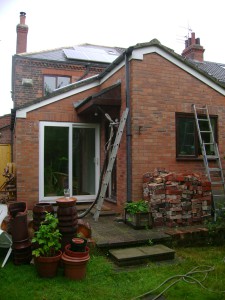
There is an extension to the rear built around 1989.
In the extension roof space there’s access to the top of a section of wall, and it’s just possible to look down into the wall cavity, and see the construction: brick on the outside, a 50-80mm cavity, and an inner layer of breeze block with 30mm of polystyrene bonded to it.
A more normal way of inspecting a cavity is for a potential installer to drill a hole and stick in a borescope.
So a little insulation, with a U-value around 0.7, but not up to modern standard.
Cavity walls can however be easily and cheaply improved by injecting insulation into the cavity. A cavity as narrow as ours, in contact with polystyrene, required a specialist product that wasn’t available locally – polystyrene beads. Thousands of tiny balls mixed with an adhesive are injected into the cavity. The adhesive ensures that in future should anyone make a hole in the kitchen wall the little beads don’t all pour out on to the floor. Which would be amusing, but quite annoying.
The extension walls are now more than twice as insulated as before, with a U-value close to the current regulations of 0.3.
Cavity Wall Insulation
-
Product Polystyrene bead cavity wall insulation, for hard to fill narrow cavities 50mm or less. Rating λ=0.033, 50mm cavity U-Value from 0.7 to 0.32 – 50% improvement Cost £315 for our 2 room single storey extension Supplier Dyson Energy Services

